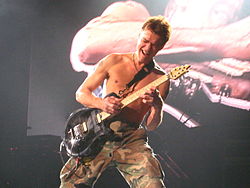Guitar/Tapping
Fretboard Tapping
[edit | edit source]
Tapping is the short name of fretboard tapping or finger tapping, a technique where the fingers hammer down (tap) against the strings in order to produce sounds rather than striking or plucking the strings. If both the left and right hand are used then it is called two-handed tapping.
It is not clear who first developed tapping but it was certainly popularized by Eddie van Halen. Van Halen was listening to Heartbreaker by Led Zeppelin and he was quite inspired by the solo, which contained a variation of tapping. This is arguably the song that pushed Van Halen to use "tapping" frequently.
A rather different kind of independent two-handed tapping was discovered by Harry DeArmond and named "The Touch System" by his student Jimmie Webster. The "Touch System" is a complete playing method rather than a technique. Another method of independent tapping was discovered by Emmett Chapman, where the right hand comes over the fretboard and lines up with the frets like the left. The three kinds of tapping techniques are:
Interdependent tapping
[edit | edit source]Interdependent tapping is by far the most common type of tapping. It is generally used as a lead guitar technique, most commonly during solos; however, a small number of songs are entirely tapped. The player's picking hand leaps out to the fretboard and begins to tap the strings with the fingers. However, one must get the pick out of the way in order to tap. Some players do this by sticking the pick between their fingers; others simply use the middle finger to tap.
The Van Halen technique of getting rid of the pick is done by moving the pick into the space between the first and second joints of his middle finger. Eruption by Eddie Van Halen is a good example of this technique.
The Touch System
[edit | edit source]
As mentioned before, this is a whole playing style and a whole book could be written about it. The first musician to play this way was pickup designer Harry DeArmond in the 1940's, who used tapping as a way to demonstrate the sensitivity of his pickups. While each hand could play its own part, DeArmond held his right hand in the same orientation as conventional guitar technique. This meant the ability of that hand to tap scale-based melody lines was limited. He taught his approach to Gretch Guitars employee Jimmie Webster, who wrote an instruction book called "The Touch System for Amplified Spanish guitar." Webster made a record and travelled around demonstrating the method. Even though it inspired a few builders (Dave bunker, for example), the Touch System was limited by the lack of equal movements for the right hand and never caught on.
The Free Hands Method
[edit | edit source]In 1969 Emmett Chapman, who had no previous knowledge of DeArmond, Webster or any other tapping guitarists, discovered that he could tap on the strings with both hands, and that by raising the neck up could align the right hand's fingers with the frets as on the left, but from above the fretboard. This made scale-based melody lines just as easy to tap in the right hand as the left, and a new way of playing a stringed instrument was born. Chapman redesigned his home-made 9-string guitar to support his new playing method, and began selling his new instrument (The Chapman Stick) to others in 1974. In 1976 Chapman published his volume of collected lessons he used for teaching guitarists and Stick players as "Free Hands: A New Discipline of Fingers on Strings."
It has been popularised by players such as Tony Levin, Nick Beggs, John Myung, Bob Culbertson, and Greg Howard, and is currently experiencing a surge in popularity due to the internet. Stanley Jordan became famous in the 1980s for using the same method on the guitar. Jordan discovered the method independently after Chapman did, was signed to Blue Note Records, and released several successful albums.The method that Chapman invented and Jordan also used allows complete self-accompaniment and counterpoint, as on piano.
